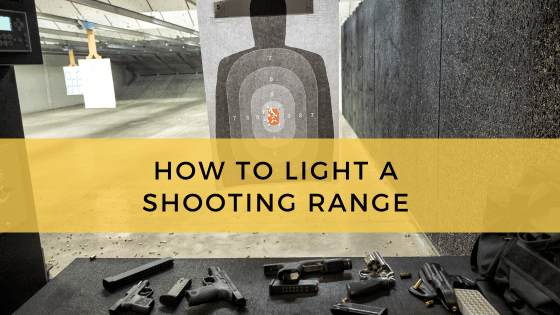
Safety is paramount at a shooting range, and this approach to safety extends to the range’s lighting. Every firing line must exhibit excellent visibility so shooters have a clear line of sight to the target. Visibility is also important in staging areas, where each shooter must prepare their firearm for use.
Poor lighting is a safety risk for shooting ranges, and it also affects shooter performance. To improve in both areas, many facility managers target their range’s lighting system for improvement. Modern lighting technologies, including LED linear tubes, are flexible in design and can be adapted for shooting ranges without difficulty.
Five Features That Shooting Range Lighting Should Offer
Shooting ranges demand a lot out of their lighting solutions. To ensure optimal visibility, safety and reliability, your lighting system should offer the following features:
- Low-glare, even illumination – Glare is obnoxious to deal with during normal conditions. At a shooting range, glare can be a serious safety hazard. Your shooting range lighting should come with low-glare features, which may include shielding or specialized optics to prevent glare at most viewing angles.
Shooting range lighting must also be evenly emitted, with no hotspots or shadows affecting visibility. Both can interfere with a shooter’s perception and result in unsafe firearm handling. Quality engineering is what ensures even illumination.
- A low-profile build – A low profile, compact fixture design will keep your lighting out of harm’s way. A low profile build also gives installers additional options in positioning the fixtures, so they can be installed closer to firing lines and staging areas without getting in the way.
- Superior dust protection – Discharging firearms produces lead dust. While ranges are equipped with ventilation technology to prevent this dust from building up, it may still reach the lights. If lead dust does infiltrate fixture housings, it can interfere with the light’s performance and cause early failure. Your shooting range lighting should be designed with dust protection. Look for IP ratings, as they detail the level of dust and moisture protection for each fixture.
- Neutral color temperature – A neutral color temperature sits between warm and cool on the color temperature spectrum. Neutral colors are preferred because they make it easier for shooters to see targets and differentiate between colors at a distance. If your range uses colored targets, neutral white fixtures are what you’re aiming for.
- Extended lifespan – No matter the business or facility, lamp replacement costs can add up. Legacy systems require frequent lamp replacements, so switching to a longer-lived light will reduce operating costs.
Reducing lamp replacement frequency is particularly important for shooting ranges as lights must be replaced as soon as they go out, and during replacement, the range will need to be shut down for safety reasons. Longer lasting fixtures allow the range to operate for longer periods without interruptions.
What Type of Lighting Works Best in Shooting Ranges?
Given the above requirements, shooting ranges around the nation are upgrading their lighting to LED solutions. LED lighting become the frontline choice quickly in the lighting industry, and it’s being adapted for a variety of settings.
For shooting ranges, LED lighting provides a few notable advantages. They include:
- Energy efficiency – LED technology is the most energy efficient form of lighting on the market. Compared to legacy options like fluorescent lighting, LED fixtures can reduce electrical bills by thousands year-over-year. LED’s efficiency is a major driver of its superior ROI – an ROI that you’ll reach faster if your lights operate for long stretches at a time.
- Durability – LED lamps are more durable than legacy bulbs and are not nearly as fragile. With their improved durability, your LED lights are less likely to fail due to mistakes during installation or maintenance.
- Safety, even when broken – In the event that an LED fixture is broken, no toxic chemicals or materials are released as a result. This isn’t true of older fixtures. Fluorescent tubes, for example, include a small amount of mercury that is released if the tube is ruptured. That’s an immediate health hazard and requires special disposal processes to manage.
- Controllability – LED lighting is compatible with modern lighting controls, including dimmers, timers, and occupancy controls. Dimmers are a popular addition to shooting ranges, as law enforcement personnel frequently train in low-light conditions. LED lights can also be color-controlled, which allows emergency personnel to train while exposed to intense red and blue light.
These engineering features makes LED technology a top option for shooting ranges, but what types of fixtures make the most sense?
Ceiling-mounted sportslighters or high bays work for many indoor ranges, as long as the ceiling is high enough. Pole-mounted sportslighters can work for outdoor ranges, as some LED lights are designed to throw illumination forward. This offset spread pattern allows installers to place lighting poles well out of firing range.
Setting up Fixtures for a Shooting Range? A Lighting Expert Can Provide Photometric Analysis
As effective as LED lighting is, it’s highly recommended that you work with a lighting expert prior to installing new fixtures or lamps. That’s because an experienced lighting designer can optimize your new system’s performance through photometric analysis. During photometric analysis, the designer uses software to model a space and simulate different lighting solutions. They can also simulate placement to determine optimal positioning.
Photometric analysis ensures you get the most lighting bang for your buck. It’s used to maximize visibility levels for every square foot of your facility, while minimizing power consumption. This additional cost efficiency will reduce the system’s ROI – an ROI that’s already expedited due to LED’s energy efficiency and longevity.






